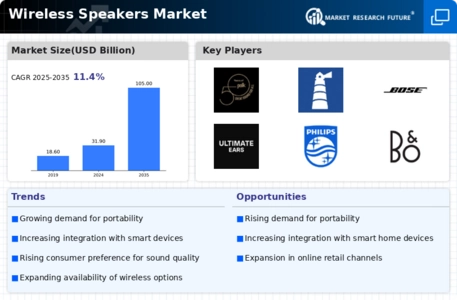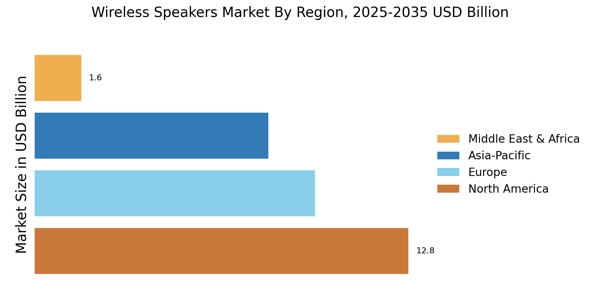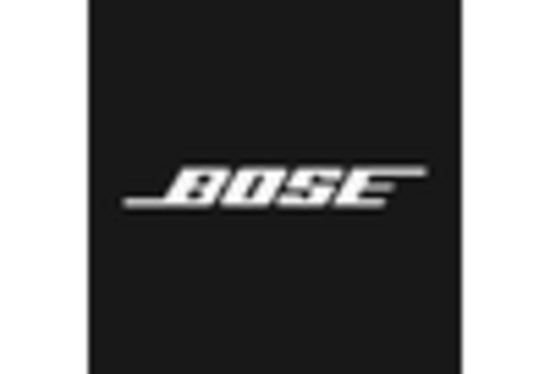Expansion of E-commerce Platforms
The expansion of e-commerce platforms is significantly influencing the Wireless Speakers Market. As online shopping becomes increasingly prevalent, consumers are more inclined to purchase wireless speakers through digital channels. This shift is facilitated by the convenience of online shopping, coupled with the availability of extensive product information and customer reviews. Market data indicates that e-commerce sales of audio products, including wireless speakers, are on the rise, reflecting changing consumer behaviors. Retailers are adapting to this trend by enhancing their online presence and offering competitive pricing, which further drives sales. This evolution in the retail landscape suggests that companies focusing on e-commerce strategies are likely to thrive in the Wireless Speakers Market.
Growth of the Home Entertainment Sector
The Wireless Speakers Market is benefiting from the robust growth of the home entertainment sector. As consumers invest in enhancing their home audio-visual experiences, the demand for wireless speakers has surged. This growth is particularly evident in the context of home theater systems, where wireless speakers provide flexibility and ease of installation. Market analysis reveals that the home entertainment segment is projected to expand, driven by trends such as binge-watching and gaming. As a result, manufacturers are increasingly offering wireless speaker solutions that cater to these specific needs, including surround sound systems and portable options. This trend indicates a promising future for the Wireless Speakers Market, as it aligns with evolving consumer preferences for immersive entertainment experiences.
Rising Popularity of Streaming Services
The proliferation of streaming services has profoundly impacted the Wireless Speakers Market. As more consumers subscribe to platforms like Spotify, Apple Music, and others, the demand for wireless speakers that can seamlessly integrate with these services has escalated. This trend is evidenced by the increasing sales of smart speakers equipped with voice assistants, which facilitate easy access to streaming content. Market data indicates that the adoption of streaming services is expected to continue its upward trajectory, thereby driving the need for compatible audio devices. Consequently, manufacturers are focusing on creating wireless speakers that not only deliver high-quality sound but also offer user-friendly interfaces for streaming. This alignment with consumer behavior positions companies favorably within the Wireless Speakers Market.
Technological Advancements in Audio Quality
The Wireless Speakers Market is experiencing a surge in demand due to rapid technological advancements in audio quality. Innovations such as high-resolution audio streaming and advanced sound processing algorithms are enhancing the listening experience. As consumers increasingly seek superior sound fidelity, manufacturers are investing in research and development to create products that meet these expectations. The introduction of features like spatial audio and multi-room capabilities further elevates the appeal of wireless speakers. According to recent data, the market for high-fidelity wireless speakers is projected to grow significantly, indicating a shift in consumer preferences towards premium audio solutions. This trend suggests that companies focusing on cutting-edge audio technology are likely to gain a competitive edge in the Wireless Speakers Market.
Increased Consumer Awareness of Sound Quality
Consumer awareness regarding sound quality is a pivotal driver in the Wireless Speakers Market. As individuals become more discerning about audio performance, they are actively seeking products that deliver exceptional sound. This heightened awareness is influencing purchasing decisions, with consumers willing to invest in higher-quality wireless speakers that offer superior audio experiences. Market data suggests that brands emphasizing sound quality and performance are likely to capture a larger share of the market. Additionally, the rise of online reviews and social media discussions around audio products has further educated consumers, leading to informed choices. This trend underscores the importance of sound quality in the Wireless Speakers Market, as it shapes consumer expectations and brand loyalty.


















Leave a Comment